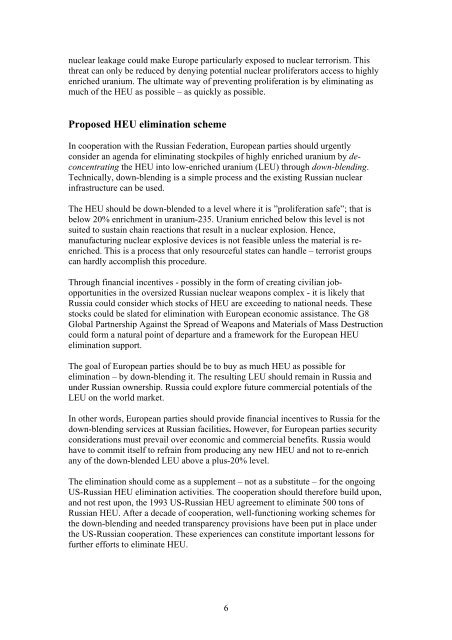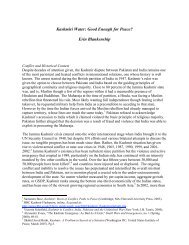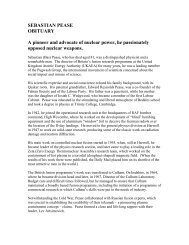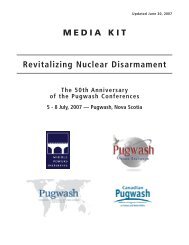Eliminating Stockpiles of Highly Enriched Uranium - Pugwash ...
Eliminating Stockpiles of Highly Enriched Uranium - Pugwash ...
Eliminating Stockpiles of Highly Enriched Uranium - Pugwash ...
Create successful ePaper yourself
Turn your PDF publications into a flip-book with our unique Google optimized e-Paper software.
nuclear leakage could make Europe particularly exposed to nuclear terrorism. This<br />
threat can only be reduced by denying potential nuclear proliferators access to highly<br />
enriched uranium. The ultimate way <strong>of</strong> preventing proliferation is by eliminating as<br />
much <strong>of</strong> the HEU as possible – as quickly as possible.<br />
Proposed HEU elimination scheme<br />
In cooperation with the Russian Federation, European parties should urgently<br />
consider an agenda for eliminating stockpiles <strong>of</strong> highly enriched uranium by deconcentrating<br />
the HEU into low-enriched uranium (LEU) through down-blending.<br />
Technically, down-blending is a simple process and the existing Russian nuclear<br />
infrastructure can be used.<br />
The HEU should be down-blended to a level where it is ”proliferation safe”; that is<br />
below 20% enrichment in uranium-235. <strong>Uranium</strong> enriched below this level is not<br />
suited to sustain chain reactions that result in a nuclear explosion. Hence,<br />
manufacturing nuclear explosive devices is not feasible unless the material is reenriched.<br />
This is a process that only resourceful states can handle – terrorist groups<br />
can hardly accomplish this procedure.<br />
Through financial incentives - possibly in the form <strong>of</strong> creating civilian jobopportunities<br />
in the oversized Russian nuclear weapons complex - it is likely that<br />
Russia could consider which stocks <strong>of</strong> HEU are exceeding to national needs. These<br />
stocks could be slated for elimination with European economic assistance. The G8<br />
Global Partnership Against the Spread <strong>of</strong> Weapons and Materials <strong>of</strong> Mass Destruction<br />
could form a natural point <strong>of</strong> departure and a framework for the European HEU<br />
elimination support.<br />
The goal <strong>of</strong> European parties should be to buy as much HEU as possible for<br />
elimination – by down-blending it. The resulting LEU should remain in Russia and<br />
under Russian ownership. Russia could explore future commercial potentials <strong>of</strong> the<br />
LEU on the world market.<br />
In other words, European parties should provide financial incentives to Russia for the<br />
down-blending services at Russian facilities. However, for European parties security<br />
considerations must prevail over economic and commercial benefits. Russia would<br />
have to commit itself to refrain from producing any new HEU and not to re-enrich<br />
any <strong>of</strong> the down-blended LEU above a plus-20% level.<br />
The elimination should come as a supplement – not as a substitute – for the ongoing<br />
US-Russian HEU elimination activities. The cooperation should therefore build upon,<br />
and not rest upon, the 1993 US-Russian HEU agreement to eliminate 500 tons <strong>of</strong><br />
Russian HEU. After a decade <strong>of</strong> cooperation, well-functioning working schemes for<br />
the down-blending and needed transparency provisions have been put in place under<br />
the US-Russian cooperation. These experiences can constitute important lessons for<br />
further efforts to eliminate HEU.<br />
6







